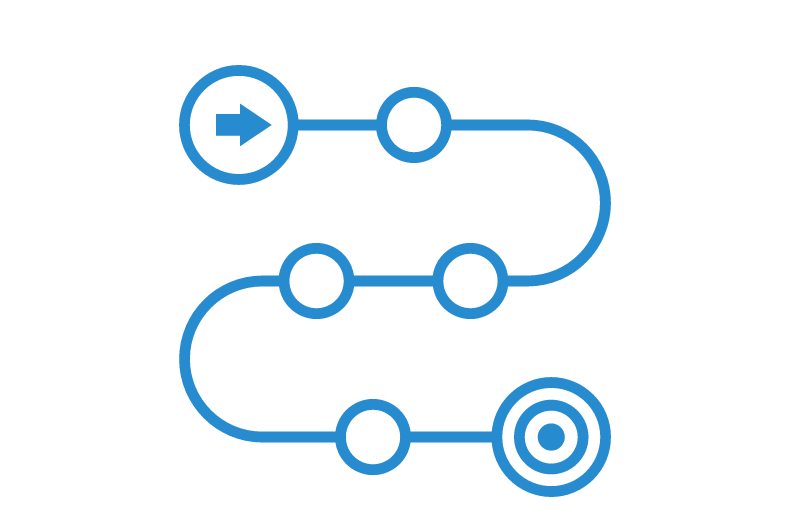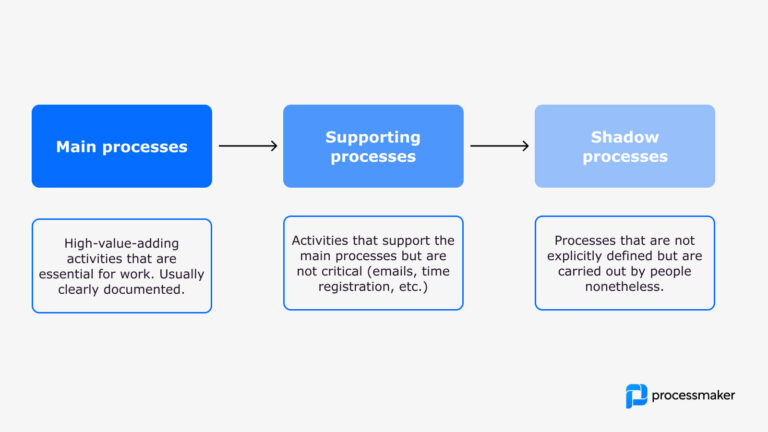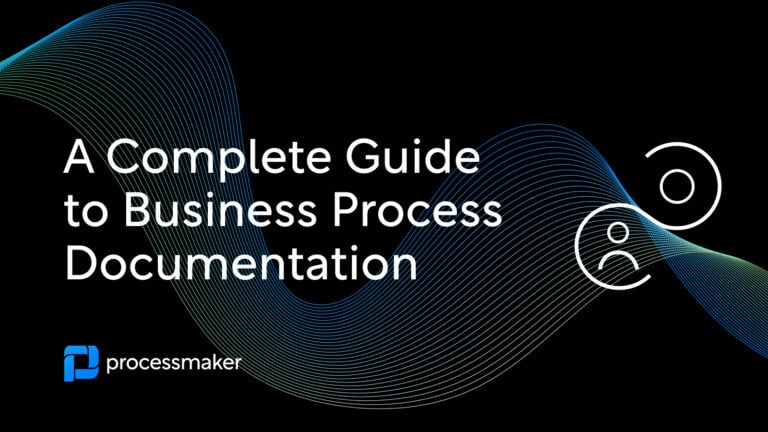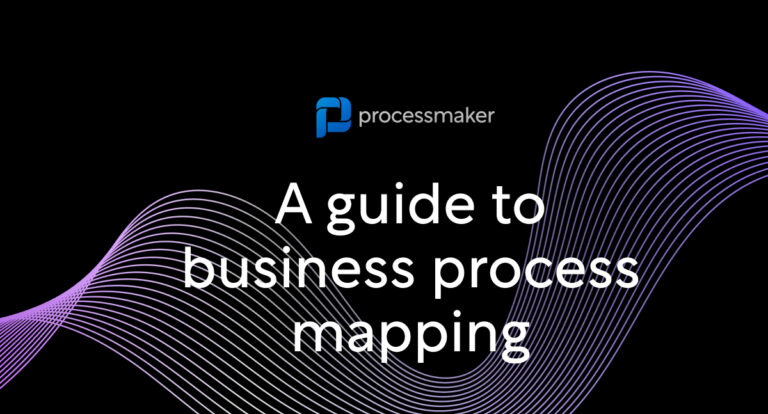Process mapping is a gamechanger for understanding business process improvement. But what does it mean? The task could seem overwhelming, so let’s cover some basics:
- What is process mapping?
- Benefits
- Examples
- Symbols and elements
- Creating a process map
Before we dive in, check out our 2023 Summer Release webinar. With the text-to-process feature, you can now create a process map in seconds just by describing it.
Forget the complexities of a learning curve, designing a process map is easier than ever. There’s no experience necessary; being tech-savvy is no longer a requirement. Let advanced AI functionality take over repetitive tasks so you can supercharge your productivity.
See for yourself! Try out the latest features of ProcessMaker Platform for free.
What is process mapping?
Process mapping is a management tool used to visually depict the flow of work and the steps and people involved in a business process. These maps are also commonly referred to as flowcharts or workflow diagrams. Organizations use this tool to gain a better understanding of a process and to improve its efficiency. By creating easy-to-follow diagrams, stakeholders can identify aspects of a process that they can improve. This includes identifying bottlenecks in workflows and other inefficiencies like repetitive tasks that are ideal for automation.
The benefits of creating a process map
Process mapping offers many benefits. We covered some of the abstract benefits, but more specific benefits of creating a process map include:

- Boosting job satisfaction. Employees know what to expect, and what their responsibilities are, and appreciate the transparency that a process map provides.
- Improve employee performance. Employees who understand their roles and where to find help when they need it are more productive.
- User friendly. Business process maps are simple to follow and are ideal for tasks like employee training and brainstorming sessions. BPM software makes it easy to design and test processes, as well as share them with the team.
- Certifications. Help organizations obtain and maintain industry certifications like ISO 9000 and 9001.
- Problem-solving. A business process map allows organizations to test hypotheticals and what-ifs, making it easier to identify problems and potential solutions.
Common examples of process maps
There are many different types of process maps. Which one you use depends largely on the type of process that you want to map and what your business objectives are. Here are some commonly used types of process maps.
Basic flowchart
A basic flowchart is useful for creating a simple map that illustrates the inputs and outputs of a process. Some ideal use cases for basic flowcharts include planning new projects, analyzing and managing workflows, and improving collaboration among team members. You can create flowcharts manually using the process map symbols that we mentioned above, or in a matter of minutes using business process management software.
High-level process map
A high-level process map, or top-down map, shows how a process works in a limited number of steps. They provide a quick snapshot of what a process does but do not go into detail about how a process is performed. High-level process maps are ideal for discussing processes with leadership or third parties that do not require specifics.
Detailed process map
Detail is useful for understanding the intricacies of a process. Unlike a high-level process map, detailed maps also include subprocesses; making this more useful for identifying inefficiencies and for documenting decision points within a process. Each stage is explored in precision detail, making this type of map a powerhouse tool for management efficiency schools like Six Sigma and Kaizen.
See for yourself! Try out the latest features of ProcessMaker Platform for free.
SIPOC
SIPOC is an acronym that helps stakeholders identify the key elements of a process. The acronym stands for supplier – inputs – process – outputs – customer. SIPOC resembles a table or chart more than it does a map. Listing out the key elements, however, is an important precursor to creating a more detailed process map. SIPOC diagrams also help to define the scope of complex business processes and are useful for stakeholders when discussing a process.
Swimlane maps
Swimlanes, or cross-functional maps, are used to show “who does what.” They separate activities into lanes or channels according to who is responsible for performing the task or process. Swimlane maps are useful for management purposes. They are ideal for training new employees and increasing accountability. Swimlane maps also help stakeholders understand workflows and how they relate to and interact with other business processes.
Value stream maps
Value stream maps show the steps required to deliver a product or service to customers. They utilize a system of symbols to illustrate information flows and tasks. Value stream maps are particularly useful for identifying waste within and between processes. They also serve an important role in identifying opportunities and planning future projects.
Symbols & Elements Used in Process Mapping

Organizations tend to develop their own internal process mapping lingo when using freehand flowcharts. This makes it difficult to communicate effectively with contractors, outside specialists, and clients.
Business process mapping notation, or BPMN, helps teams overcome these “language barriers” by adopting a standard set of symbols to use in their process maps. BPMN bridges the gap between technical information and the non-techies on your team that need to grasp it. The BPMN dictionary is rich with elements commonly known as flowchart symbols or flowchart shapes. They help eliminate ambiguity and make sure all stakeholders understand your new process map.
The symbols come from the Unified Modeling Language (UML). Software engineers created UML to provide a standardized way to analyze and design software programs. UML has, however, become one of the most popular systems used for business process modeling.
Symbols fall into the following categories:
- Process/operation symbols
- Branching and control of flow symbols
- Input and output symbols
- File and information storage symbols
- Data processing symbols
For most organizations, however, utilizing a small portion of the most common symbols will be enough to complete a process map. Some commonly used symbols include:
Process: A rectangle represents a particular process and its activities and functions.
Flowline → An arrow shows both the direction of flow and the connection between steps.
Terminator: A terminator shows the beginning or end of a process flow.
Decision: Indicates that a decision must be made, after which the flow will follow a predefined path based on that decision.
Document(s): A rectangle with a wavy base depicts a single document or piece of information that can be read by people. Multiple rectangles with wavy bases indicate that there is more than one document that can be reviewed.
Delay: A delay symbol means there is a pause in the process before the flow continues.
Manual entry: This symbol shows that a procedure will be performed manually by a person.
How to create a process map
It is essential to include all key stakeholders in process design. Everyone should understand the organization’s objectives and the basics of mapping. Manual creation involves drawing out by hand utilizing the process map symbols that we mentioned above. To simplify the process and improve collaboration, you can use business process management software. The software makes it easy to design and test processes, save your work, and share it with team members.

Identify the process
The first step is to identify the right business process. This could be a process with a hefty price tag or one that involves manual to-dos and is prone to delays. Name the process and list it at the top of the document.
Assemble your team
One of the most crucial aspects of the mapping process is to include those who are most familiar with its inner workings. The input of key stakeholders ensures that process mapping is thorough and that you are not leaving out important details or considerations. Spend some time brainstorming with your team at the outset. Determine who does what, when it is done, and how it is performed.
Gather data
Following your initial brainstorming session, start gathering relevant data and information. Determine when the process begins and ends. List out all the steps required to complete the process. Identify the inputs, outputs, and the people involved.
List out the steps in sequential order
Once you have a complete list of the steps involved, work with your team to place them into sequential order. Identify the event that triggers the process and the actions and decisions that bring it to completion.
Draw the map using symbols
Include all the information that you identified in earlier steps and use the process symbols that we identified earlier in this guide. For instance, use an oval (terminator) to show the beginning of the process. This should be an accurate depiction of the process as it currently exists.
Analyze
Once your process map is completed, you can use it to identify bottlenecks and inefficiencies. Look for manual tasks that can be improved through automation. Identify steps that can be eliminated. Get feedback and suggestions from each member of your team.
Improve your process
Implement the mapping techniques and tools that you identified in the prior step. If the improvements and suggestions will have a broad impact on the process, avoid implementing them all at once. Prioritize the improvements. Start small to avoid potential disruptions to the process. Monitor the improvements. Determine whether further improvements are needed.
Avoid these common process map pitfalls
Here are the most common stumbling blocks to avoid when putting together your process map.
- Too complex: When picking the right type of process map, it’s vital that you “know your audience.” Presenting an efficiency-maximizing workflow to upper management vs. the IT team that needs to implement it requires two different communication styles. Consider using multiple maps to illustrate different levels of detail. You can think of your process mapping toolkit as a set of nesting dolls: you can start with the big picture for some stakeholders while saving more intricate diagrams for more tech-savvy collaborators.
- Too simple: Conversely, you can create a map that is too light on detail. For example, when you’re expanding your team, you need to establish a common language that thinkers of all backgrounds can act on. That’s the power of leveraging BPMN: team members don’t have to struggle to interpret rough sketches. Everyone speaks using the same process mapping terms and symbols.
- Ignoring stakeholder input: When designing a process map, it’s important to interact with all stakeholders—including the very staffers charged with performing the tasks. Interview, observe, and listen. Without understanding the nuances of the specific job duties you are mapping, you’ll miss out on key elements, causing employees to ignore new procedures and revert back to old ways.
By bearing in mind these common mistakes, you can ensure your process plan succeeds and doesn’t become one of the 4 in 10 plans that fail due to lack of a clearly defined strategy.
The best tools for getting started with process mapping
So where do you turn when you’re ready to get started? Here are four tools you can use in your process mapping, from quick-and-easy sketching tools to robust workflow automation platforms that actually execute the tasks.

- The easiest way to get started is through a simple flowchart sketch. You can draw out the flow of tasks that underpin a vital process. If you’re hesitant about going freehand, you can pluck a free flowchart template from the low-code design platform Canva. It’s a great way to kick off the brainstorming process.
- Eventually, your back-of-the-napkin sketch will require more detail. This is when you can hop over to a tool like Gitmind. This free browser app offers more process-oriented diagrams like SIPOC and swimlanes. You can dive deeper into sub-processes and share your plan with colleagues for feedback.
- Lucidchart is another favorite amongst beginner process modelers. This intelligent diagramming tool is loaded with helpful elements like BPMN symbols and templates like detailed maps, value stream maps, and detailed process maps. You can even use their mobile apps to arrange processes on the go.
- When it’s time for an enterprise-grade process mapping solution, it’s time for a platform like ProcessMaker. With ProcessMaker, you can bring your process map to life. Automation passes information between people and systems, automatically checking off to-dos without human interference. And now with the 2023 Summer Release, you can design a process map in seconds.
How does process mapping generate Hyper-Productivity
Process mapping plays a pivotal role in driving hyper-productivity within organizations. By visually depicting and analyzing workflows, it provides a clear understanding of how tasks and activities are carried out. This transparency allows for the identification of bottlenecks, redundancies, and inefficiencies, which can then be streamlined or eliminated. Process mapping also facilitates standardization, ensuring that best practices are consistently followed. As a result, teams work more cohesively, decision-making becomes more data-driven, and productivity soars.
Process mapping through ProcessMaker is an incomparable tool when your business is ready to scale. It codifies how you do business to better establish consistency as your team grows. During your onboarding process, you can more easily teach newcomers how things work. You can create a baseline for more predictable results by jettisoning staffers’ “own ways” of doing things. Additionally, the strategy helps you find any gaps in personnel, procedures, or technology as your organization expands.
Process mapping is an incredibly effective tool for improving operational efficiency and offers a broad range of organizational benefits. To get the most out of it, try ProcessMaker’s industry-leading low-code intelligent BPM software. Easily create enterprise-grade business processes and leverage ProcessMaker’s powerful automation solutions.
Chat with our team to learn how you can leverage process mapping, and try our free trial.





